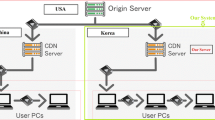Abstract
With the rapidly development of broadband networks, more and more users nowadays tend to acquire their desired videos from media-on-demand servers. How to efficiently provide multimedia contents for a large number of heterogeneous users on the Internet has become a noticeable issue. In our previous work, we proposed the Loopback-MDC scheme on CDN-P2P network to address such a scalability issue. In this paper, we present the design and implementation of a novel peer-to-peer streaming system with the Loopback-MDC on actual networks, named TuBeck. The TuBeck consists of preprocessor, server, peer, and player modules with the support of network infrastructure library. In TuBeck, multimedia sources are preprocessed to multiple descriptions. Each description is divided as a sequence of H.264/AVC chunks by modified JM encoder for real-time streaming. The network infrastructure library provides the nodes (server and peers) with the fundamental functionalities of network connections and communications. Message exchange and streaming control among nodes follow the pre-defined LM protocol. The server, peer, and player modules are functionally multithreaded in order to enhance the system performance. The experimental results show that the Loopback-MDC is practical for realizing a P2P streaming system in terms of the server loading, CPU/Memory usage, and efficiency of failure recovery with respect to various arrival rates, failure rates, and viewing qualities.






























Similar content being viewed by others
References
Akyol E, Tekalp A, Civanlar M (2006) Adaptive peer-to-peer video streaming with optimized flexible multiple description coding, pp 725–728
Akyol E, Tekalp AM, Civanlar MR (2007) A flexible multiple description coding framework for adaptive peer-to-peer video streaming. IEEE J Sel Topics Signal Process 1:231–245
Bai HH, Wang AH, Zhao Y, Pan JS, Abraham A (2011) Distributed multiple description coding: principles, algorithms and systems. Springer-Verlag New York Inc
Campana O, Cattani A, Giusti AD, Milani S, Zandona N, Calvagno G (2006) Multiple description coding schemes for the h.264/avc coder. In: Proceedings of the international conference on wireless recognizable terminals and protocols, pp 217–221
Castro M, Druschel P, Kermarrec AM, Nandi A, Rowstron A, Singh A (2003) Splitstream: high-bandwidth multicast in cooperative environments. In: Proc. of ACM symposium on operating system principles, pp 298–313
Chen Z, Yin H, Lin C, Liu X, Chen Y (2007) Towards a trustworthy and controllable peer-server-peer media streaming: an analytical study and an industrial perspective. In: Proc. of global telecommunications conference (Globecom ’07). IEEE, pp 2086–2090
Dai L, Cui Y, Xue Y (2007) Maximizing throughput in layered peer-to-peer streaming. In: IEEE international conference on communications, 2007 (ICC ’07), pp 1734–1739
Dong Y, Kusmierek E, Duan Z, Du D (2004) A hybrid client-assistant streaming architecture: modeling and analysis. In: Proc. of 8th internet and multimedia systems and spplications (IMSA)
Fouliras P, Xanthos S, Tsantalis N, Manitsaris A (2004) Lemp: lightweight efficient multicast protocol for video on demand. In: SAC ’04: proceedings of the 2004 ACM symposium on applied computing (2004), pp 1226–1231. doi:10.1145/967900.968150
Goyal VK (2001) Multiple description coding: compression meets the network. IEEE Signal Process Mag 18:74–93
Guo Y, Suh K, Kurose J, Towsley D (2003) P2cast: peer-to-peer patching scheme for vod service. In: Proceedings of the twelfth international world wide web conference
Hua KA, Cai Y, Sheu S (1998) Patching: a multicast technique for true video-on-demand services. In: Proceedings of the sixth ACM international conference on multimedia, pp 191–200
Hunag C, Wang A, Li J, Ross KW (2008) Understanding hybrid cdn-p2p: why limitlight needs its own red swoosh. In: Proc. of Nossdav’08. ACM, pp 75–80
Joint Video Team (JVT) of ISO/IEC MPEG & ITU-T VCEG. Joint model (jm) - h.264/avc reference software. http://iphome.hhi.de/suehring/tml/. Ver. 18.0. Accessed 8 June 2012
Kusmierek E, Dong Y, Du DHC (2006) Loopback: exploiting collaborative caches for large-scale streaming. IEEE Trans Multimedia 8(2):233–242
Lin CS (2011) Enhancing p2p live streaming performance by balancing description distribution and available forwarding bandwidth. Int J Commun Syst 24(5):568–585
Lin CS, Lee IT (2010) Applying multiple description coding to enhance the streaming scalability on cdn-p2p network. Int J Commun Syst 23(5):553–568
Lin CS, Syu WT, Lee IT (2008) Improving the scalability of p2p streaming based on fine-grained balancing scheme. In: Proc. of the IEEE 22nd international conference on advanced information networking and applications (AINA2008), pp 795–802
Ma W, Du DHC (2002) Reducing bandwidth requirement for delivering video over wide area networks with proxy server. IEEE Trans Multimedia 4(4):539–550
Ma WH, Du DHC (2004) Design a progressive video caching policy for video proxy servers. IEEE Trans Multimedia 6(4):599–610
Padmanabhan V, Wang H, Chou P (2003) Resilient peer-to-peer streaming. In: Proc. of IEEE network protocols, pp 16–27
Padmanabhan VN, Wang HJ, Chou PA, Sripanidkulchai K (2002) Distributing streaming media content using cooperative networking. In: Proc. of ACM NOSSDAV, pp 177–186
Sheu S, Hua KA, Tavanapong W (1997) Chaining: a generalized batching technique for video-on-demand. In: Proceedings of IEEE international conference on multimedia computing and systems ’97, pp 110–117
Tran DA, Hua KA, Do T (2003) Zigzag: an efficient peer-to-peer scheme for media streaming. In: Twenty-second annual joint conference of the IEEE computer and communications
Xiao X, Shi Y, Gao Y (2008) On optimal scheduling for layered video streaming in heterogeneous peer-to-peer networks. In: MM ’08: proceeding of the 16th ACM international conference on multimedia. ACM, New York, NY, USA, pp 785–788
Xu D, Kulkarni SS, Rosenberg C, Chai HK (2004) A cdn-p2p hybrid architecture for cost-effective streaming media distribution. Comput Netw 44(3):353–382
Acknowledgement
This work was partially supported by National Science Council under contracts NSC 97-2221-E-024-014-MY3.
Author information
Authors and Affiliations
Corresponding author
Rights and permissions
About this article
Cite this article
Lin, CS., Chang, RH. & Lin, JW. TuBeck: a novel peer-to-peer streaming system with Loopback-MDC for scalable H.264/AVC videos. Multimed Tools Appl 72, 1653–1679 (2014). https://doi.org/10.1007/s11042-013-1482-0
Published:
Issue Date:
DOI: https://doi.org/10.1007/s11042-013-1482-0




